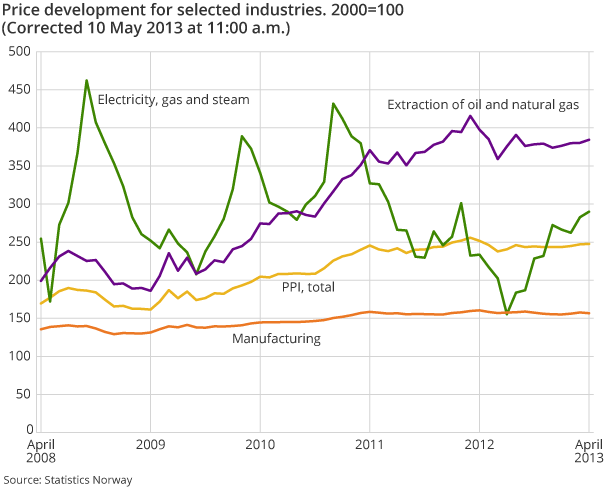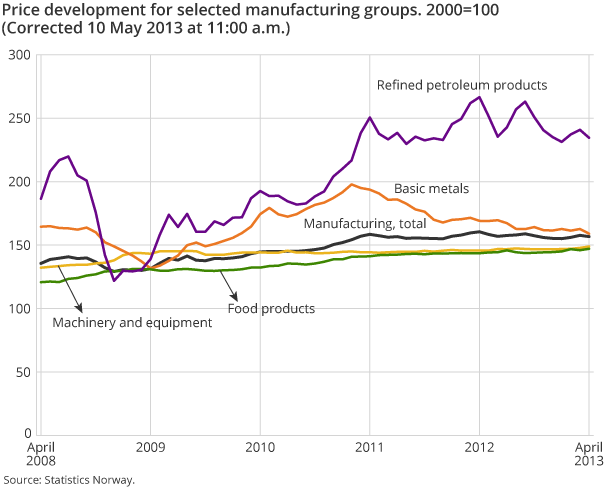Content
Published:
This is an archived release.
Small increase in the PPI
The producer price index for oil and gas, manufacturing, mining and electricity (PPI) increased by 0.2 per cent from March to April. Higher prices of natural gas and electricity were the most important factors behind the increase. From April 2012 to April 2013, the PPI fell by 1.6 per cent.
| Per cent | Index | Weights1 | ||
|---|---|---|---|---|
| April 2013 / March 2013 | April 2013 / April 2012 | April 2013 | ||
| 1The weights are updated annually, and are valid for the entire year. | ||||
| Industrial Classification | ||||
| Extraction, mining, manufacturing and electricity | 0.2 | -1.6 | 247.7 | 1 000.0 |
| Extraction and related services | 0.9 | -3.4 | 381.9 | 482.3 |
| Mining and quarrying | 0.2 | 7.6 | 167.1 | 9.6 |
| Manufacturing | -0.6 | -2.4 | 156.7 | 466.1 |
| Food, beverages and tobacco | 0.7 | 2.5 | 146.6 | 94.6 |
| Refined petroleum, chemicals, pharmaceuticals | -2.5 | -9.1 | 214.9 | 136.5 |
| Basic metals | -2.3 | -6.0 | 159.0 | 41.3 |
| Machinery and equipment | 0.7 | 2.2 | 148.9 | 47.9 |
| Electricity, gas and steam | 2.6 | 24.1 | 290.0 | 42.0 |
The PPI rose by 0.2 per cent from March to April. As in the previous period, the rise in the PPI was driven by higher prices for natural gas and electricity. Electricity prices increased by 2.6 per cent due to a higher system price on the Nordic financial electricity market Nord Pool, as well as higher prices for electricity sold to Norwegian households. Prices of electricity were especially high in the first two weeks in April. According to Norwegian Water Resources and Energy Directorate (NVE), low electricity production due to low hydro reservoir levels, and high power demand due to cold weather were among the main reasons for the high electricity prices in the first half of the month. Prices fell slightly in late April as a result of increased precipitation, higher electricity production and lower power demand.
The 1.1 per cent price increase within extraction of oil and natural gas can be entirely explained by the sharp increase in prices of natural gas in April. With regard to the price of crude oil; Brent Blend measured in Norwegian kroner, the prices decreased by about 5 per cent. The price decline in oil was a key factor that helped curb the rise in the total PPI in April. Other industries with price decreases in April were refined petroleum products, basic metals and chemical and pharmaceutical products. Prices in these groups fell by 2.6, 2.3 and 2.0 per cent respectively.
Twelve-month change: oil prices pulled the PPI down
The PPI fell by 1.6 per cent from April 2012 to April 2013. Lower prices of crude oil and refined petroleum products was the main reason for the decrease in the PPI. Another industry with a fall in prices was mining support service activities, where prices dropped by 3.4 per cent from April 2012 to April 2013.
Lower prices in basic metals also contributed to the decrease in the PPI in this twelve-month period. After a price spike in February 2011, prices in basic metals fell by over 19 per cent from February 2011 to April 2013. The substantial fall in prices of non-ferrous metals such as aluminium and nickel contributed to the downturn in the industry.
Two important industries with price increases from April 2012 to April 2013 were electricity and food products. Prices in these industries increased by 24.1 and 2.4 per cent respectively, which helped curb the decline in the overall PPI.
Additional information
Contact
-
Producer price index
E-mail: produsentpris@ssb.no
tel.: (+47) 21 09 40 00
-
Elisabeth Mælum
E-mail: elisabeth.maelum@ssb.no
tel.: (+47) 97 01 28 49
-
Morten Madshus
E-mail: morten.madshus@ssb.no
tel.: (+47) 40 90 26 94
-
Monika Græsli Engebretsen
E-mail: monika.graesli.engebretsen@ssb.no
tel.: (+47) 40 90 23 71
-
Håvard Georg Jensen
E-mail: havard.jensen@ssb.no
tel.: (+47) 40 90 26 86


